The effects of mind - Mapping on Vietnamese efl students’ reading skills
The ability to decode, analyze, and interpret written materials is an essential component of success
at the tertiary level (Ntereke & Ramoroka, 2017). According to Barnett (1989), reading comprehension is
considered as an integral part of the teaching and learning process as its role in second language acquisition.
Not only does it serve important purposes after the student's complete language study at school, but it also
promotes literacy skills later on. Nevertheless, in the EFL context of Vietnam, research into reading
comprehension shows that most Vietnamese students meet with great challenges when dealing with reading
texts. They usually do not understand the texts and cannot complete the tasks due to their ineffective and
inefficient strategies (Wood et al., 1998). Second and foreign language research also suggests that one
effective comprehension strategy is the use of mind-mapping (Liu, Chen & Chang, 2010). However, in
Vietnam, there seems to be a paucity of research into the use of mind-mapping in reading among first-year
Vietnamese undergraduates. This is the motivation for the current study to be conducted to examine the
effectiveness of mind-mapping on EFL students’ reading skills.
The study seeks answers to the following research questions:
1. Does mind-mapping have an effect on Vietnamese freshman students’ reading skills?
2. What’s the students’ attitude towards the use of mind-mapping on reading skills?
There are two hypotheses following the first research question:
Null hypothesis: There is no significant difference in the pre- and post-test score in students’ reading
skills.
Alternative hypothesis: There is a significant difference in the pre- and post-test scores in students’
reading skills.
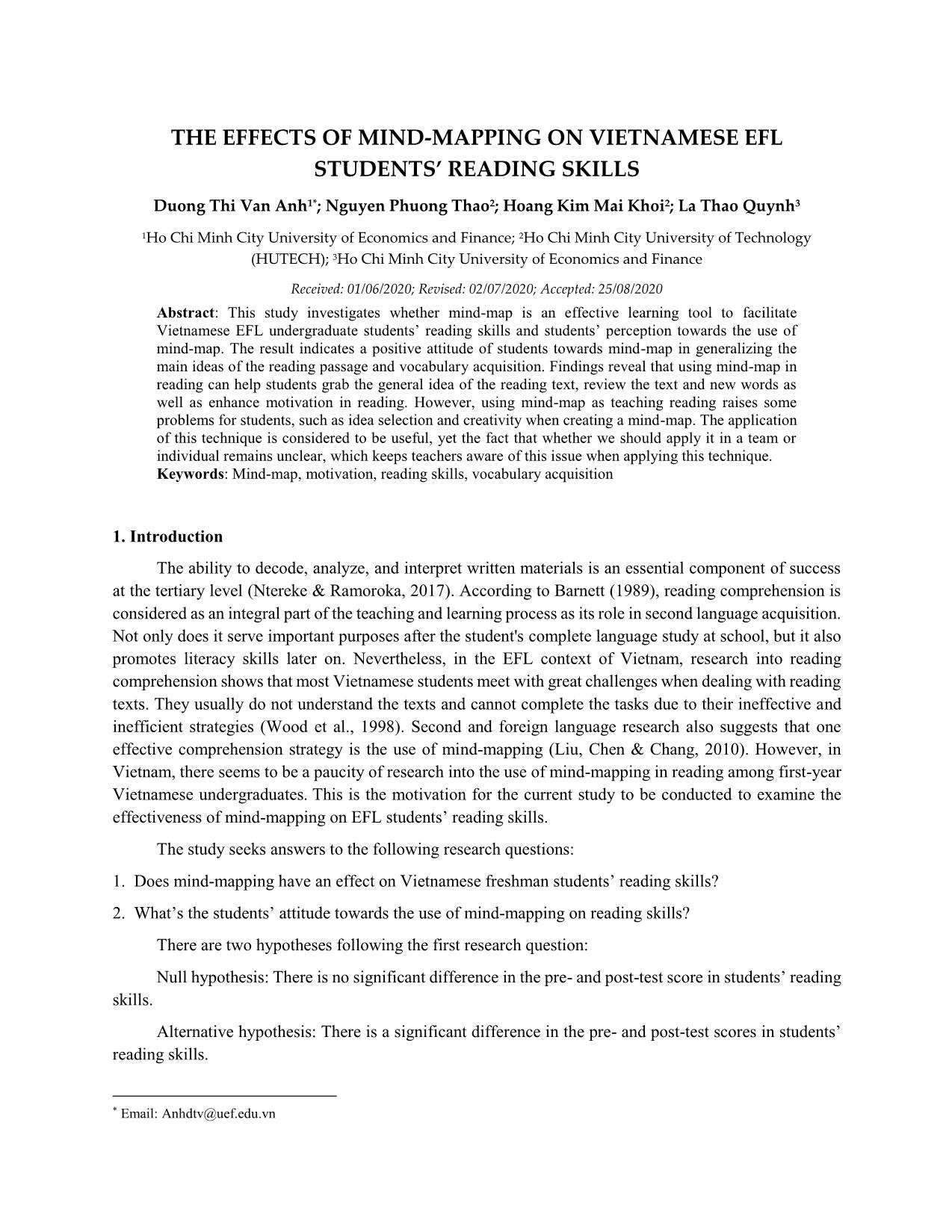
Trang 1
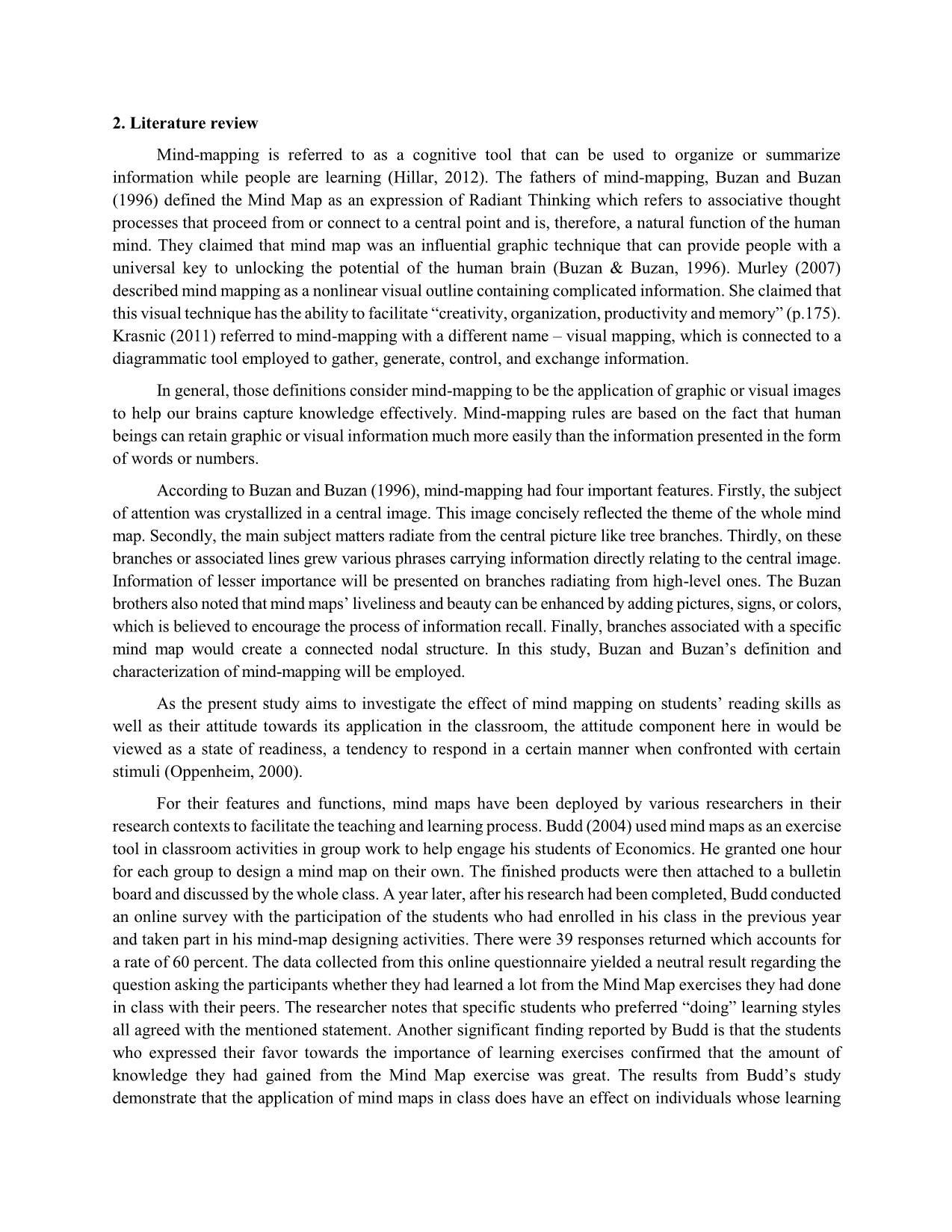
Trang 2
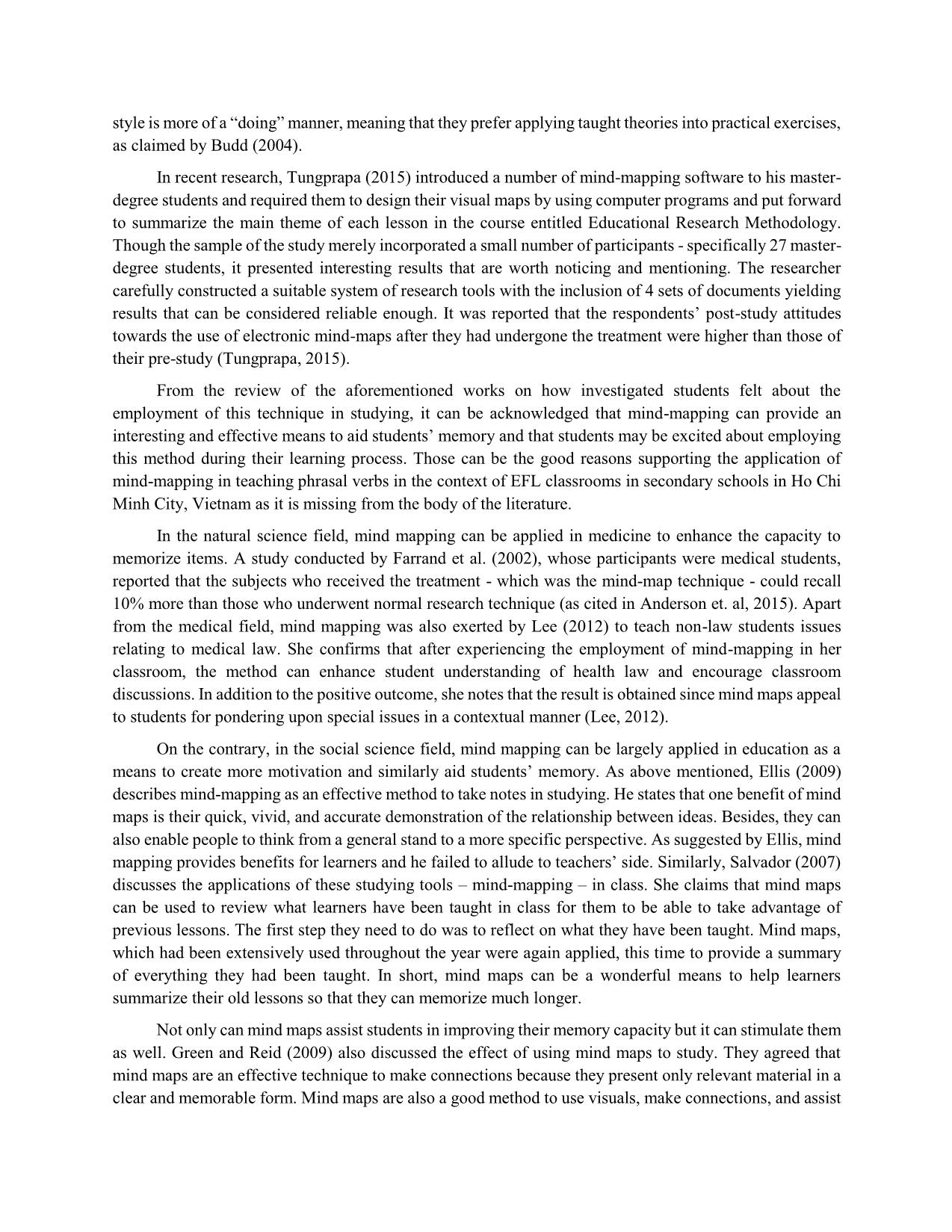
Trang 3
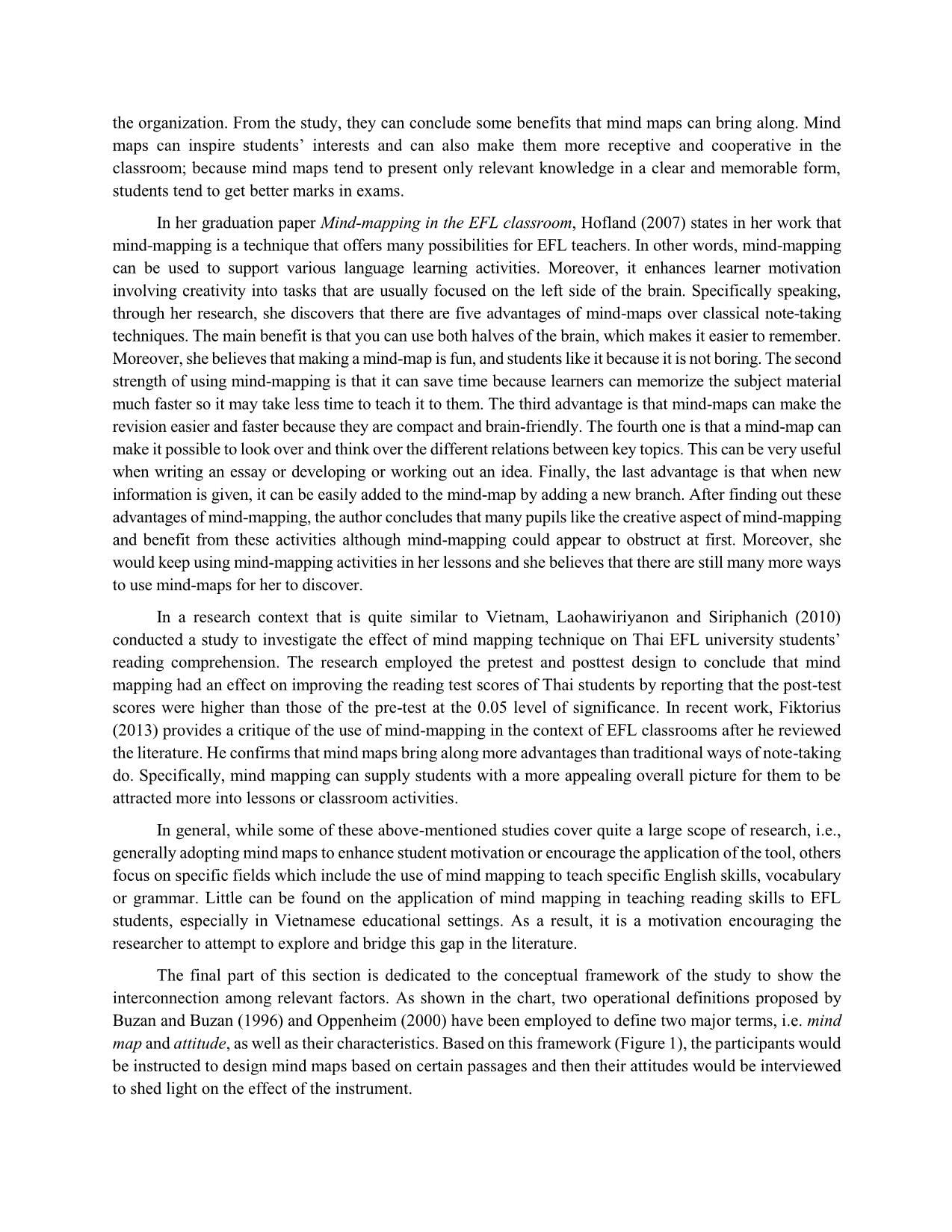
Trang 4
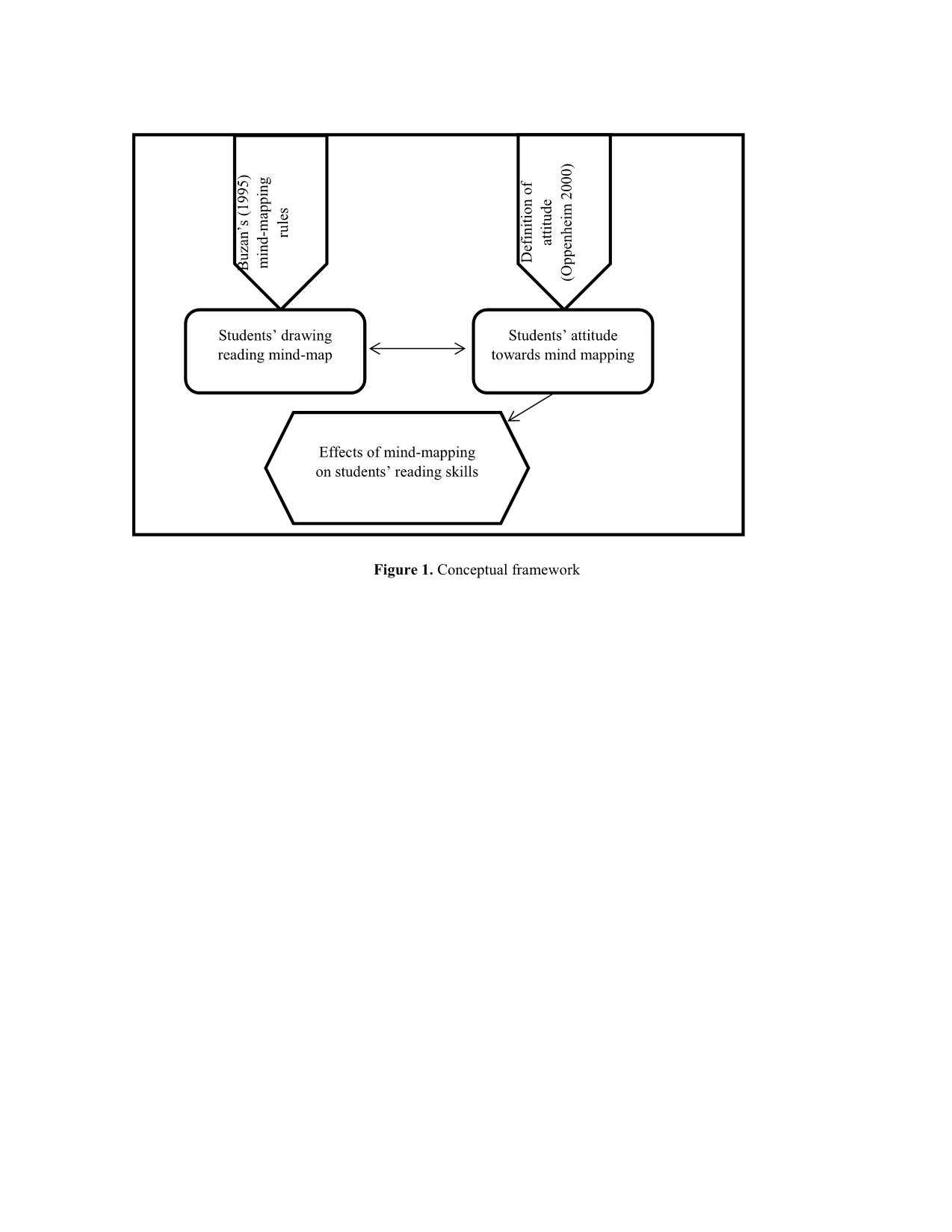
Trang 5
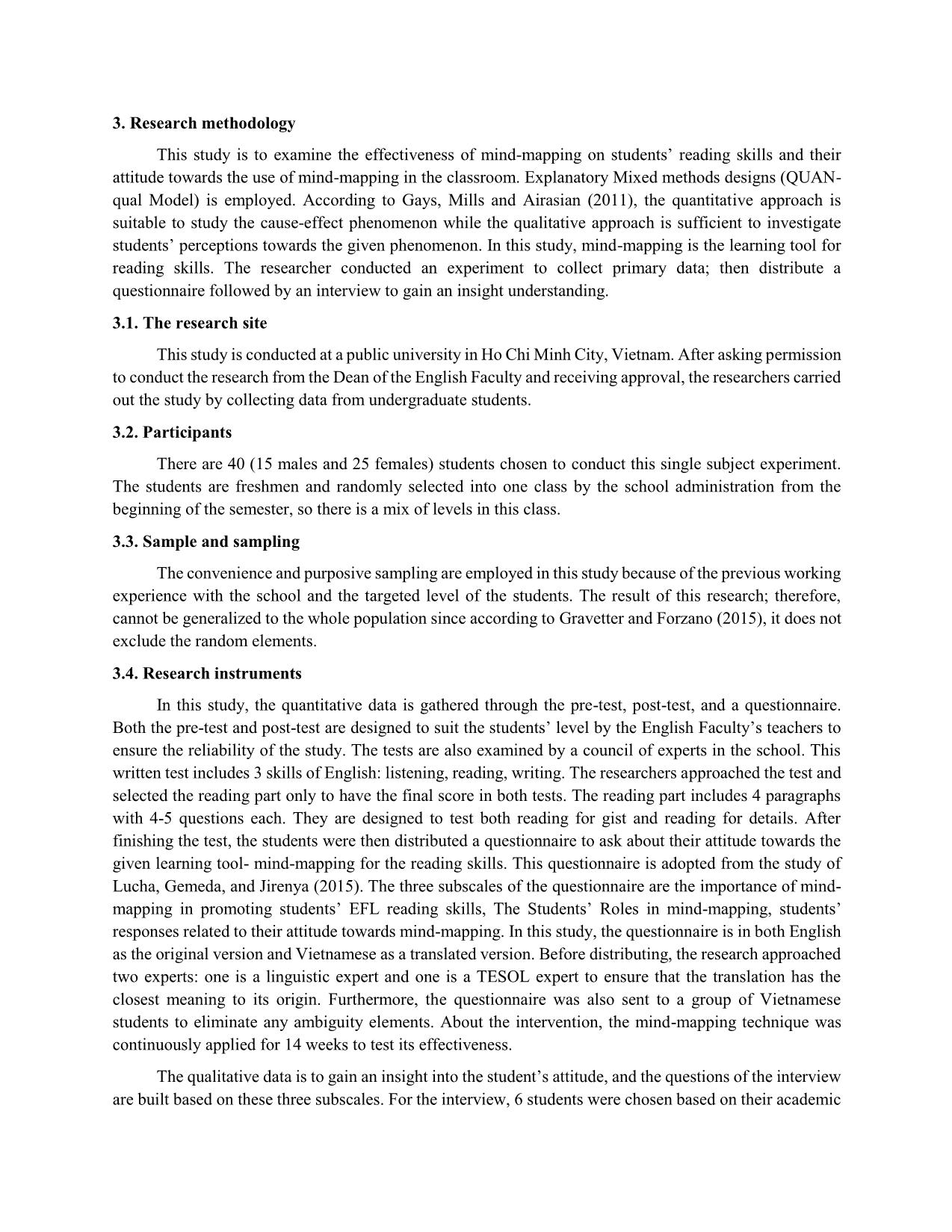
Trang 6
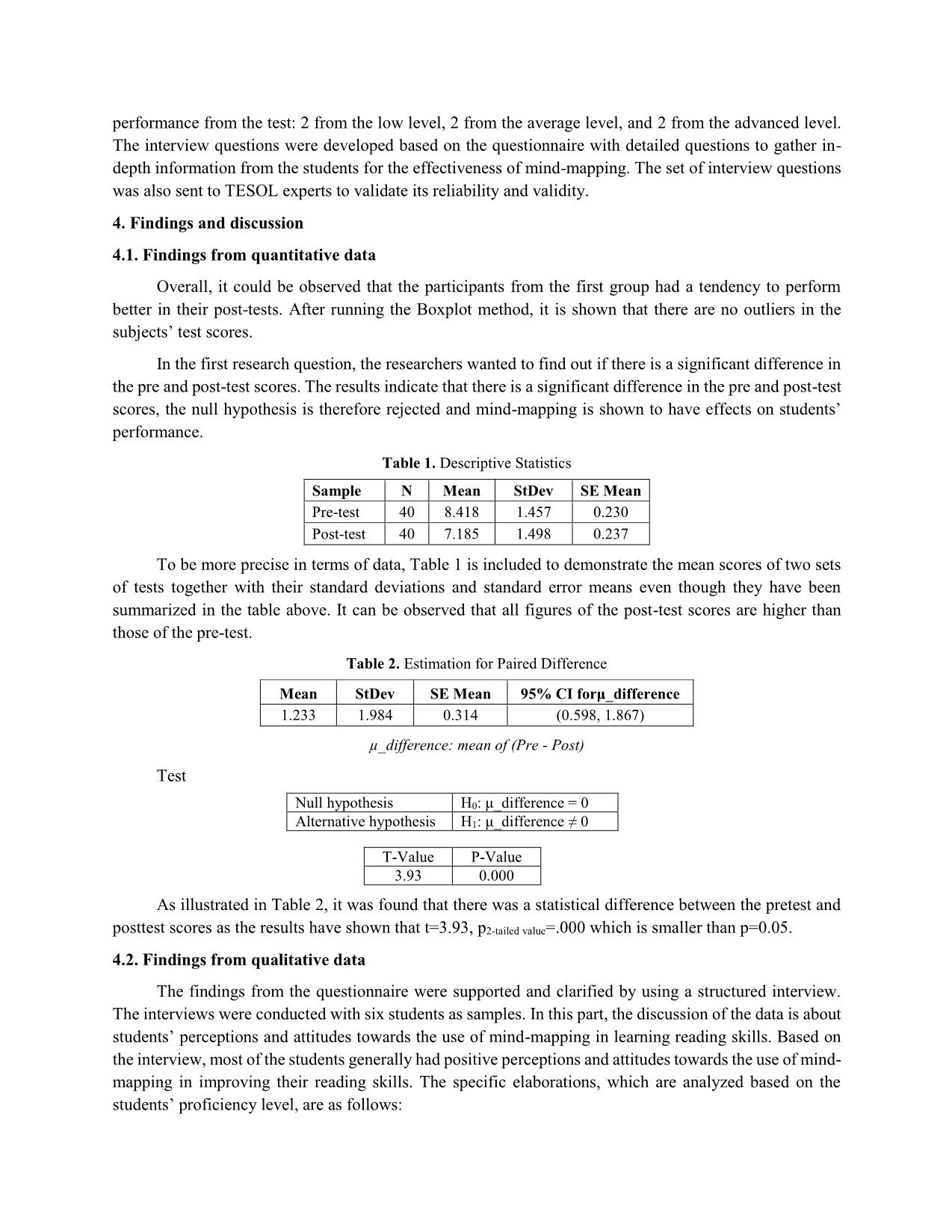
Trang 7

Trang 8
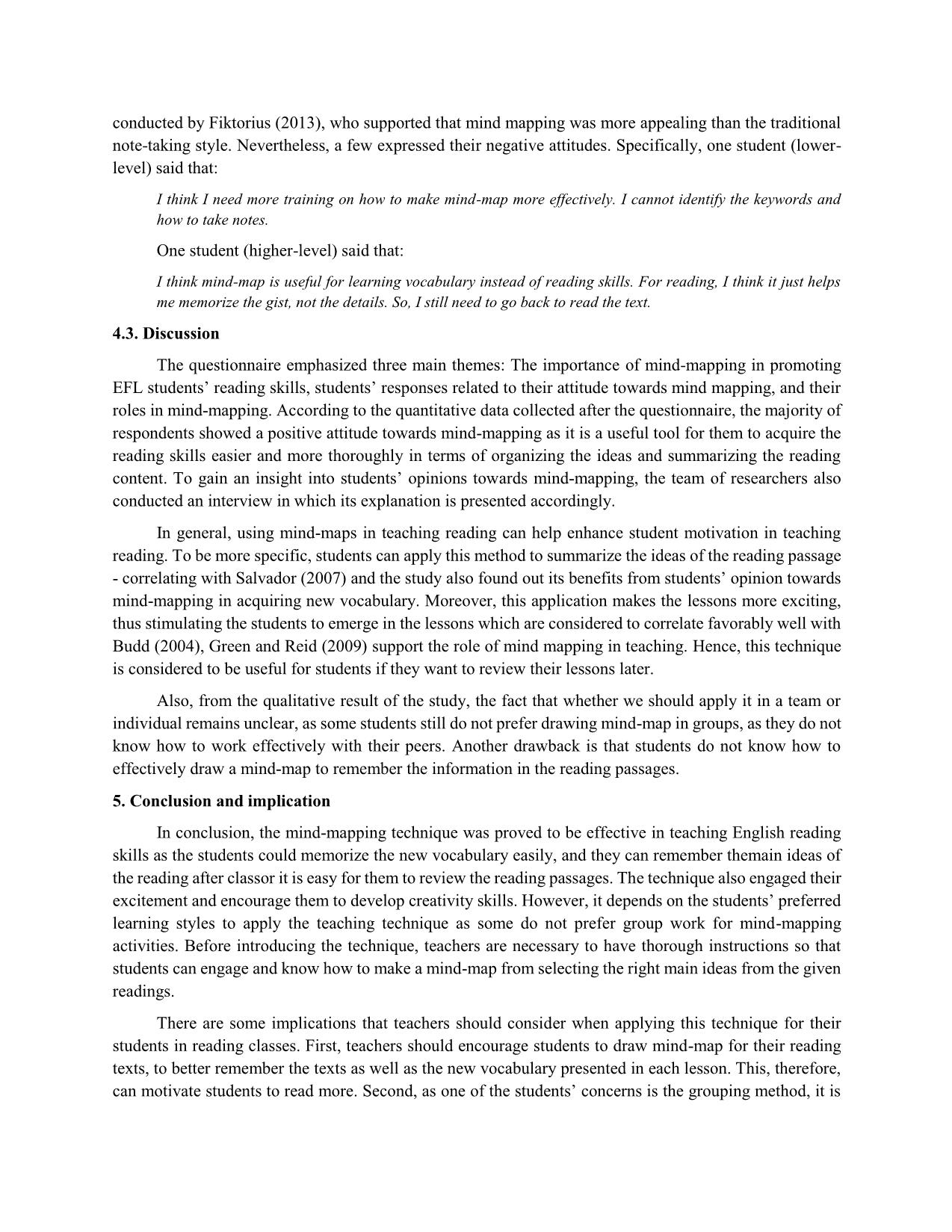
Trang 9

Trang 10
Tải về để xem bản đầy đủ
Tóm tắt nội dung tài liệu: The effects of mind - Mapping on Vietnamese efl students’ reading skills
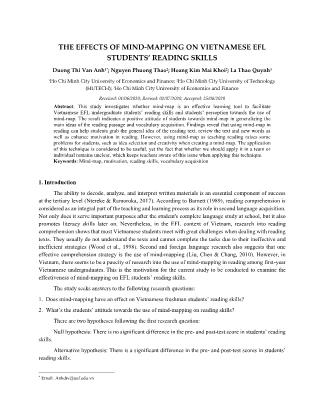
THE EFFECTS OF MIND-MAPPING ON VIETNAMESE EFL STUDENTS’ READING SKILLS Duong Thi Van Anh1*; Nguyen Phuong Thao2; Hoang Kim Mai Khoi2; La Thao Quynh3 1Ho Chi Minh City University of Economics and Finance; 2Ho Chi Minh City University of Technology (HUTECH); 3Ho Chi Minh City University of Economics and Finance Received: 01/06/2020; Revised: 02/07/2020; Accepted: 25/08/2020 Abstract: This study investigates whether mind-map is an effective learning tool to facilitate Vietnamese EFL undergraduate students’ reading skills and students’ perception towards the use of mind-map. The result indicates a positive attitude of students towards mind-map in generalizing the main ideas of the reading passage and vocabulary acquisition. Findings reveal that using mind-map in reading can help students grab the general idea of the reading text, review the text and new words as well as enhance motivation in reading. However, using mind-map as teaching reading raises some problems for students, such as idea selection and creativity when creating a mind-map. The application of this technique is considered to be useful, yet the fact that whether we should apply it in a team or individual remains unclear, which keeps teachers aware of this issue when applying this technique. Keywords: Mind-map, motivation, reading skills, vocabulary acquisition 1. Introduction The ability to decode, analyze, and interpret written materials is an essential component of success at the tertiary level (Ntereke & Ramoroka, 2017). According to Barnett (1989), reading comprehension is considered as an integral part of the teaching and learning process as its role in second language acquisition. Not only does it serve important purposes after the student's complete language study at school, but it also promotes literacy skills later on. Nevertheless, in the EFL context of Vietnam, research into reading comprehension shows that most Vietnamese students meet with great challenges when dealing with reading texts. They usually do not understand the texts and cannot complete the tasks due to their ineffective and inefficient strategies (Wood et al., 1998). Second and foreign language research also suggests that one effective comprehension strategy is the use of mind-mapping (Liu, Chen & Chang, 2010). However, in Vietnam, there seems to be a paucity of research into the use of mind-mapping in reading among first-year Vietnamese undergraduates. This is the motivation for the current study to be conducted to examine the effectiveness of mind-mapping on EFL students’ reading skills. The study seeks answers to the following research questions: 1. Does mind-mapping have an effect on Vietnamese freshman students’ reading skills? 2. What’s the students’ attitude towards the use of mind-mapping on reading skills? There are two hypotheses following the first research question: Null hypothesis: There is no significant difference in the pre- and post-test score in students’ reading skills. Alternative hypothesis: There is a significant difference in the pre- and post-test scores in students’ reading skills. * Email: Anhdtv@uef.edu.vn 2. Literature review Mind-mapping is referred to as a cognitive tool that can be used to organize or summarize information while people are learning (Hillar, 2012). The fathers of mind-mapping, Buzan and Buzan (1996) defined the Mind Map as an expression of Radiant Thinking which refers to associative thought processes that proceed from or connect to a central point and is, therefore, a natural function of the human mind. They claimed that mind map was an influential graphic technique that can provide people with a universal key to unlocking the potential of the human brain (Buzan & Buzan, 1996). Murley (2007) described mind mapping as a nonlinear visual outline containing complicated information. She claimed that this visual technique has the ability to facilitate “creativity, organization, productivity and memory” (p.175). Krasnic (2011) referred to mind-mapping with a different name – visual mapping, which is connected to a diagrammatic tool employed to gather, generate, control, and exchange information. In general, those definitions consider mind-mapping to be the application of graphic or visual images to help our brains capture knowledge effectively. Mind-mapping rules are based on the fact that human beings can retain graphic or visual information much more easily than the information presented in the form of words or numbers. According to Buzan and Buzan (1996), mind-mapping had four important features. Firstly, the subject of attention was crystallized in a central image. This image concisely reflected the theme of the whole mind map. Secondly, the main subject matters radiate from the central picture like tree branches. Thirdly, on these branches or associated lines grew various phrases carrying information directly rela ... h question, the researchers wanted to find out if there is a significant difference in the pre and post-test scores. The results indicate that there is a significant difference in the pre and post-test scores, the null hypothesis is therefore rejected and mind-mapping is shown to have effects on students’ performance. Table 1. Descriptive Statistics Sample N Mean StDev SE Mean Pre-test 40 8.418 1.457 0.230 Post-test 40 7.185 1.498 0.237 To be more precise in terms of data, Table 1 is included to demonstrate the mean scores of two sets of tests together with their standard deviations and standard error means even though they have been summarized in the table above. It can be observed that all figures of the post-test scores are higher than those of the pre-test. Table 2. Estimation for Paired Difference Mean StDev SE Mean 95% CI forμ_difference 1.233 1.984 0.314 (0.598, 1.867) µ_difference: mean of (Pre - Post) Test Null hypothesis H0: μ_difference = 0 Alternative hypothesis H1: μ_difference ≠ 0 T-Value P-Value 3.93 0.000 As illustrated in Table 2, it was found that there was a statistical difference between the pretest and posttest scores as the results have shown that t=3.93, p2-tailed value=.000 which is smaller than p=0.05. 4.2. Findings from qualitative data The findings from the questionnaire were supported and clarified by using a structured interview. The interviews were conducted with six students as samples. In this part, the discussion of the data is about students’ perceptions and attitudes towards the use of mind-mapping in learning reading skills. Based on the interview, most of the students generally had positive perceptions and attitudes towards the use of mind- mapping in improving their reading skills. The specific elaborations, which are analyzed based on the students’ proficiency level, are as follows: The first question related to the importance of mind-mapping in promoting students' EFL reading skills. The students were asked whether they found mind-mapping an effective tool to improve their reading skills and whether it helps motivate them to further practice reading skills. Most of the students generally had positive perceptions towards the use of mind-mapping while some of them also raised a few concerns. Regarding the effectiveness of mind-mapping on reading skills and motivation, 4 students from all levels agreed that mind-mapping has effectiveness in their studying reading skills. This finding was consistent with Hoffland’s (2007) and Salvador’s (2007) studies, which both concluded that the use of mind-map helped EFL learners to memorize the content much better. One student said: Using mind-maps helped me get an overall understanding of the text. It made it easier for me to remember the main points and learn new words. They also expressed that their motivation in reading improved thanks to mind-mapping. One student stated that: It helps me to review the lesson much faster and I like this about mind map. I can also be creative in the way I design my mind-map, so it helps me remember the information much longer. Nevertheless, a few students were uncertain of the effectiveness of mind-map and thus were not strongly motivated. Two students (one from higher - and one from middle-level of proficiency) expressed that: Well, I think the texts are quite short and the information is easy to understand, so there is no need to use a mind-map. For short simple texts, I think I have been used to the traditional method of note-taking and I can learn better this way. I think mind-mapping is more suitable for longer and more condensed information- packed texts. In addition, one student (low-level) said: think mind-map is useful but I found it difficult to identify keywords and which information I should note. I need more training on using mind-map. The second question is about the students' roles in mind mapping. The students were asked whether they interacted with other group members and whether this interaction benefited them. A few expressed that they did learn new vocabulary from their peers. One student (lower-level) said that: When I don’t understand the words, I ask my classmate for help. My friend also helps me with how to make mind-map On the other hand, most of the students raised concerns about the idea of pair-work/group-work in mind-mapping. One student (higher-level) stated that: I think it requires all the members to know how to work in groups. Otherwise, this is not effective - only one student does all the work while others are not involved. Similarly, one student (middle-level) expressed that: I think I work alone better than in a group. I can look up words on the internet if I want to know the meanings. If the text is difficult, I will ask my friends for help. The last question is concerned with the students’ attitudes towards mind-mapping. Most of the students affirmed that mind-mapping made reading lessons more interesting to learn besides the traditional teaching method of translation and the “ask and answer question” style. This was in line with the study conducted by Fiktorius (2013), who supported that mind mapping was more appealing than the traditional note-taking style. Nevertheless, a few expressed their negative attitudes. Specifically, one student (lower- level) said that: I think I need more training on how to make mind-map more effectively. I cannot identify the keywords and how to take notes. One student (higher-level) said that: I think mind-map is useful for learning vocabulary instead of reading skills. For reading, I think it just helps me memorize the gist, not the details. So, I still need to go back to read the text. 4.3. Discussion The questionnaire emphasized three main themes: The importance of mind-mapping in promoting EFL students’ reading skills, students’ responses related to their attitude towards mind mapping, and their roles in mind-mapping. According to the quantitative data collected after the questionnaire, the majority of respondents showed a positive attitude towards mind-mapping as it is a useful tool for them to acquire the reading skills easier and more thoroughly in terms of organizing the ideas and summarizing the reading content. To gain an insight into students’ opinions towards mind-mapping, the team of researchers also conducted an interview in which its explanation is presented accordingly. In general, using mind-maps in teaching reading can help enhance student motivation in teaching reading. To be more specific, students can apply this method to summarize the ideas of the reading passage - correlating with Salvador (2007) and the study also found out its benefits from students’ opinion towards mind-mapping in acquiring new vocabulary. Moreover, this application makes the lessons more exciting, thus stimulating the students to emerge in the lessons which are considered to correlate favorably well with Budd (2004), Green and Reid (2009) support the role of mind mapping in teaching. Hence, this technique is considered to be useful for students if they want to review their lessons later. Also, from the qualitative result of the study, the fact that whether we should apply it in a team or individual remains unclear, as some students still do not prefer drawing mind-map in groups, as they do not know how to work effectively with their peers. Another drawback is that students do not know how to effectively draw a mind-map to remember the information in the reading passages. 5. Conclusion and implication In conclusion, the mind-mapping technique was proved to be effective in teaching English reading skills as the students could memorize the new vocabulary easily, and they can remember themain ideas of the reading after classor it is easy for them to review the reading passages. The technique also engaged their excitement and encourage them to develop creativity skills. However, it depends on the students’ preferred learning styles to apply the teaching technique as some do not prefer group work for mind-mapping activities. Before introducing the technique, teachers are necessary to have thorough instructions so that students can engage and know how to make a mind-map from selecting the right main ideas from the given readings. There are some implications that teachers should consider when applying this technique for their students in reading classes. First, teachers should encourage students to draw mind-map for their reading texts, to better remember the texts as well as the new vocabulary presented in each lesson. This, therefore, can motivate students to read more. Second, as one of the students’ concerns is the grouping method, it is better to be aware of group work. If teachers wish to let students work in groups, it is suggested that teachers should be the one to supervise and ask students to work together. Another method is to ask students to work in pairs or individually. In this way, they can create their mind-map with their own choice and at their own pace. Thirdly, the fact that how to draw a mind-map can pose some difficulties for students, it is suggested that teachers should train students on how to draw a mind-map. To be more specific, they should instruct students on the basic notions and organizations of a mind-map. Then they encourage students to select the essential information to be drawn on the mind-map. Doing this can erase the initial confusion when students encounter mind-maps and help them to be more confident when employing this technique in their reading lessons. References Anderson, M.C., Baddeley, A., & Eysenck, M.W. (2015). Memory (2nd edition.). New York, NY: Psychology Press. Barnett, M.A. (1989). More than meets the eye, foreign language learner reading: Theory and practice (Language in education). Prentice Hall, Regents, Englewood Cliffs, New Jersey 07632. Budd, J.W. (2004). Mind maps as classroom practice. The Journal of Economic Education, 35(1), 35-46, DOI: 10.3200/JECE.35.1. Buzan, T., & Buzan, B. (1996). The mind map book: How to use radiant thinking to maximize your brain's untapped potential. New York: Plume. Ellis, D. (2009). Becoming a master student (12th edition). New York, NY: Wadsworth Cengage Learning. Farrand, P., Hussain, F., & Hennessy, E. (2002). The efficacy of the 'mind map' study technique. Medical education, 36(5), 426-431. Doi: 10.1046/j.1365-2923.2002.01205.x. Fiktorius, T. (2013). The use of the mind-mapping technique in the EFL classroom: A critique and demonstration of methods. Retrieved on May, 24th, 2015 from: https://www.academia.edu/. Gay, L., Mills, G., & Airasian, P. (2011). Educational research: Competencies for analysis and applications (10th edition). Canada: Pearson Higher Ed. Gravetter, F., & Forzano, L.A. (2015). Research methods for the behavioral sciences. Ontario, Canada: Nelson Education. Green, S., & Reid, G. (2009). Effective learning: Ideas in action. New York, NY: Continuum International Publishing Group. Hillar, S.P. (2012). Mind mapping with free mind. Birmingham, England: Packt Publishing Ltd. Hofland, C. (2007). Mind-mapping in the EFL classroom. Fontys Lerarenopleiding Sittard. Krasnic, T. (2011). How to study with mind maps: The concise learning method. Alexandria, VA: Concise Books Publishing. Laohawiriyanon, C., & Siriphanich, P. (2010). Using mind mapping technique to improve reading comprehension ability of Thai EFL university students. In The 2nd International Conference on Humanities and Social Sciences. Faculty of Liberal Arts, Prince of Songkla University Strategies. Songkla University Hat Yai, Songkhla, Thailand. Lee, S.B. (2012). Using mind mapping to bridge the gap in teaching health law to non-law students. Annals of Health Law, 21(25), 281-290. Liu, P.L., Chen, C.J., & Chang, Y.J. (2010). Effects of a computer-assisted concept mapping learning strategy on EFL college students' English reading comprehension. Computers & Education, 54(2), 436- 445. Lucha, Z.T., Gemeda, F., & Jirenya, K. (2015). Assessment of EFL learners' attitude towards cooperative language learning: Limu preparatory school, east wollega zone in focus. Science, Technology and Arts Research Journal, 4(3), 240-252. Murley, D. (2007). Technology for everyone: Mind mapping complex information. Law Libr. J., 99, 175. Ntereke, B.B., & Ramoroka, B.T. (2017). Reading competency of first-year undergraduate students at University of Botswana: A case study. Reading & Writing, 8(1), 1-11. Oppenheim, A.N. (2000). Questionnaire design, interviewing and attitude measurement (new edition). London, England: Bloomsbury Publishing. Salvador, N. (2007). Using posters and mind maps to review grammar and vocabulary. Retrieved on February 23rd, 2015 from: www.xtec.cat/~nsalvado/spring/spring_2005/Portfolio_apac.pdf. Tungprapa, T. (2015). Effect of using the electronic mind map in the educational research methodology course for Master-degree students in the Faculty of Education. International Journal of Information and Education Technology, 5(11), 803. Wood, E., Motz, M., & Wiloughby, T. (1998). Examining students' retrospective memories of development. Journal of Educational Psychology, 90, 698-704. ẢNH HƯỞNG CỦA SƠ ĐỒ TƯ DUY ĐỐI VỚI CÁC KỸ NĂNG ĐỌC CỦA SINH VIÊN VIỆT NAM KHI HỌC TIẾNG ANH Tóm tắt: Một số nghiên cứu tập trung vào tính hiệu quả của sơ đồ tư duy đối với các kỹ năng đọc. Kết quả của những nghiên cứu này chỉ ra rằng việc sử dụng sơ đồ tư duy có mối tương quan tích cực với việc sinh viên đọc hiểu. Nhằm nỗ lực để cung cấp thêm bằng chứng cho những phát hiện trước đó, nghiên cứu này điều tra xem liệu sơ đồ tư duy có phải là một công cụ học tập hiệu quả để tạo điều kiện cho các kỹ năng đọc của sinh viên đại học học tiếng Anh tại Việt Nam và nhận thức của sinh viên về việc sử dụng sơ đồ tư duy. Kết quả cho thấy sinh viên có thái độ tích cực đối với sơ đồ tư duy trong việc khái quát các ý chính của các bài đọc và thu thập từ vựng; tuy nhiên, cũng rút ra được một số nhược điểm nhất định. Các phát hiện cho thấy rằng việc sử dụng sơ đồ tư duy trong môn đọc hiểu có thể giúp học sinh nắm bắt ý tưởng chung về bài đọc, xem lại văn bản và từ mới cũng như tăng cường động lực trong việc đọc. Nói cách khác, việc áp dụng kỹ thuật này được coi là hữu ích. Tuy nhiên, thực tế là liệu chúng ta nên áp dụng trong một nhóm hay đối với cá nhân vẫn còn chưa rõ ràng. Hơn nữa, sử dụng sơ đồ tư duy trong việc dạy môn đọc tạo ra một số vấn đề cho học sinh, chẳng hạn như lựa chọn ý tưởng và tính sáng tạo khi thiết kế sơ đồ tư duy. Vì vậy, giáo viên cần lưu ý về vấn đề này khi áp dụng kỹ thuật này. Từ khóa: Sơ đồ tư duy, động lực, kỹ năng đọc, tiếp thu từ vựng
File đính kèm:
 the_effects_of_mind_mapping_on_vietnamese_efl_students_readi.pdf
the_effects_of_mind_mapping_on_vietnamese_efl_students_readi.pdf

